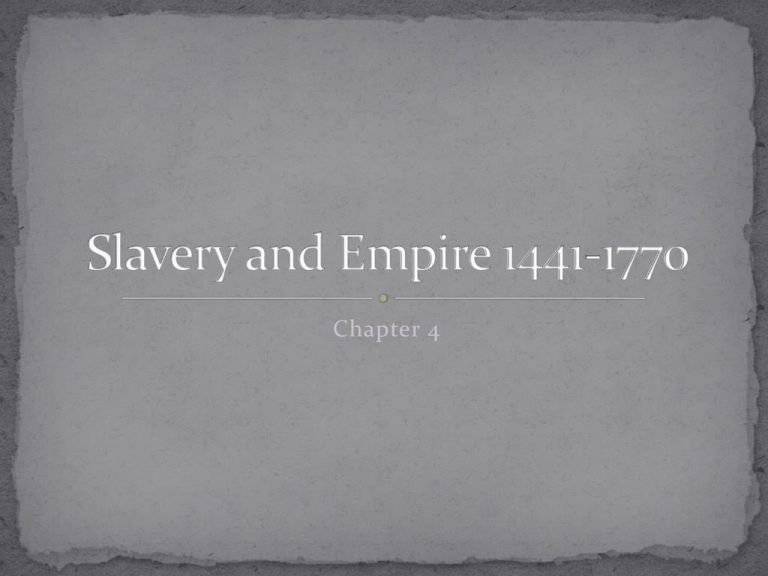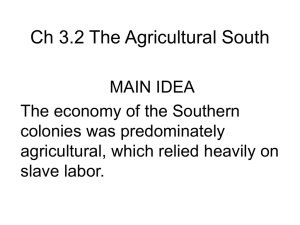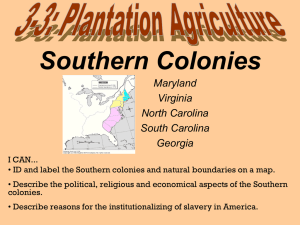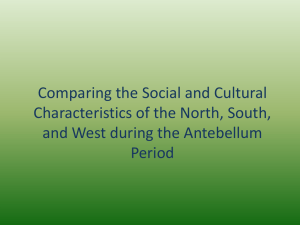AP US History- Chapter 4
advertisement

Chapter 4 The development of the slavery system The history of the slave trade and the Middle Passage Community development among Africans Americans in the 18th century The connections between the institution of slavery & the imperial system of the 18th century The early history of racism in America Sugar & Slavery- West Africans- Spain and Hundreds of different Portugal used African slaves to work their sugar plantations. Sugar and slaves were the centerpiece of the European colonial system. peoples lived on the coast of West Africa They were sophisticated farmers Local communities were organized by kinship Movement of Africans across the Atlantic was the largest forced migration in world history. Africans outnumbered Europeans immigrants 6 to 1before the 19th century. Started 15th century and ended around 1807 12 million Africans transported to America Peak period- 1701- 1810 Twice as many men as women were enslaved Ages 15 to 30 The 2nd leg of the Triangular Trade….from Africa to America. 1 in 6 Africans died during the passage across the Atlantic. Top Deck Ship Blueprint Society with Slaves Slave Society Chesapeake- slavery was Chesapeake after 1675slavery was the dominant form of labor one of one form of labor The tobacco colonies- In the Chesapeake region (18th century), tobacco was the single most important crop. The increase in tobacco demand corresponded with the increased demand for more slaves. The lower south- generally states were slaves states from their beginnings. Families- the most Culture- 18th century important institution for the development of the African American community and culture. Kinship was formed by slaves living and working together…..fictive kinship. important to development due to high birthrate of country born African Americans. Religion- The Great Awakening Music and dance Language- Gullah and Geechee Africanization of the south Acculturation worked both ways. Many English in the colonies were being Africanized as well. Food Religious leadership Medical magic Woodcarving, metalworks Child rearing Resistance to slavery Malingered Mistreated tools and animals Destroyed property Ran away in maroons Established fugitive communities & networks Revolted- NY 1741 Contributed to the economic development in 3 ways: Profits from slavery generated a source of capital investments…banks, insurance companies, canals, harbors. Supplied the raw cotton needed for the Industrial Revolution…led to the formation of many jobs Created a huge market for exports. Definition- An economic system in which the government intervenes in the economy for the purpose of increasing national wealth. Political control of the economy by the mother country. Views the economy as a “zero-sum game” where total economic gains were at least equal to total losses. The goal was to acquire & hoard the fixed amount of wealth in the world. The nation with the most wealth, would be the most powerful. Navigation Acts Laws that defined the colonies as supplier of raw materials and market for English goods. Other nations were forbidden to trade in the colonies and goods could be shipped in English ships only Enumerated Commodities Goods that could only be shipped to England: sugar, molasses, rum, tobacco, rice, indigo, furs, skins, tar, turpentine. These were often called enumerated commodities. Salutary Neglect The idea that any laws or regulations that was contrary to good business were ignored or not enforced. Both the colonies and Britain made huge profits. The colonial society benefitted planters, merchants and white colonists. Northern port cities were had a tight commercial relationship with the South. The North provided shipping, banking and insurance services. The institution of slavery contributed to the growth of the North. Colonial exports: Chesapeake colonies: tobacco South Carolina: rice and indigo Middle Colonies: wheat In what ways did colonial policies encourage the growth of slavery? Southern Social Structure: Small elite of wealthy planters. ½ of all white adult makes were small planters & farmers. A substantial portion of colonists owned no land or slaves. Upper class- slaveowning elite Had large plantations with over 100 slaves. Influenced the politics, economy and social rules of the South. Had a very distant relationship with slaves. Middle class land owners Whites used legalities to create distinctions between them and slaves: 1670- Free Africans couldn’t own Christian slaves 1680- Slaves couldn’t a white person 1691- Slaves & whites couldn’t have interracial sexual relationships





